BA Business Decision Making Essay: Project Analysis and Evaluation
VerifiedAdded on 2022/12/29
|9
|1411
|75
Essay
AI Summary
This essay, submitted by a student, examines the business decision-making process for XYZ plc, a budget hotel chain. The essay explores two potential projects: a software project and a laundrette project, evaluating them using the payback period and net present value (NPV) methods. It calculates and compares the payback periods and NPVs of both projects to determine which offers a better return on investment. The analysis also considers financial factors such as income, working capital, and profit, as well as non-financial factors like skills, technology, and marketing strategies. The essay concludes by recommending a project based on the financial analysis and discusses the advantages and disadvantages of the methodologies used. The essay aims to provide a comprehensive understanding of financial decision-making in a business context.

Essay on Business
Decision Making
Decision Making
Paraphrase This Document
Need a fresh take? Get an instant paraphrase of this document with our AI Paraphraser
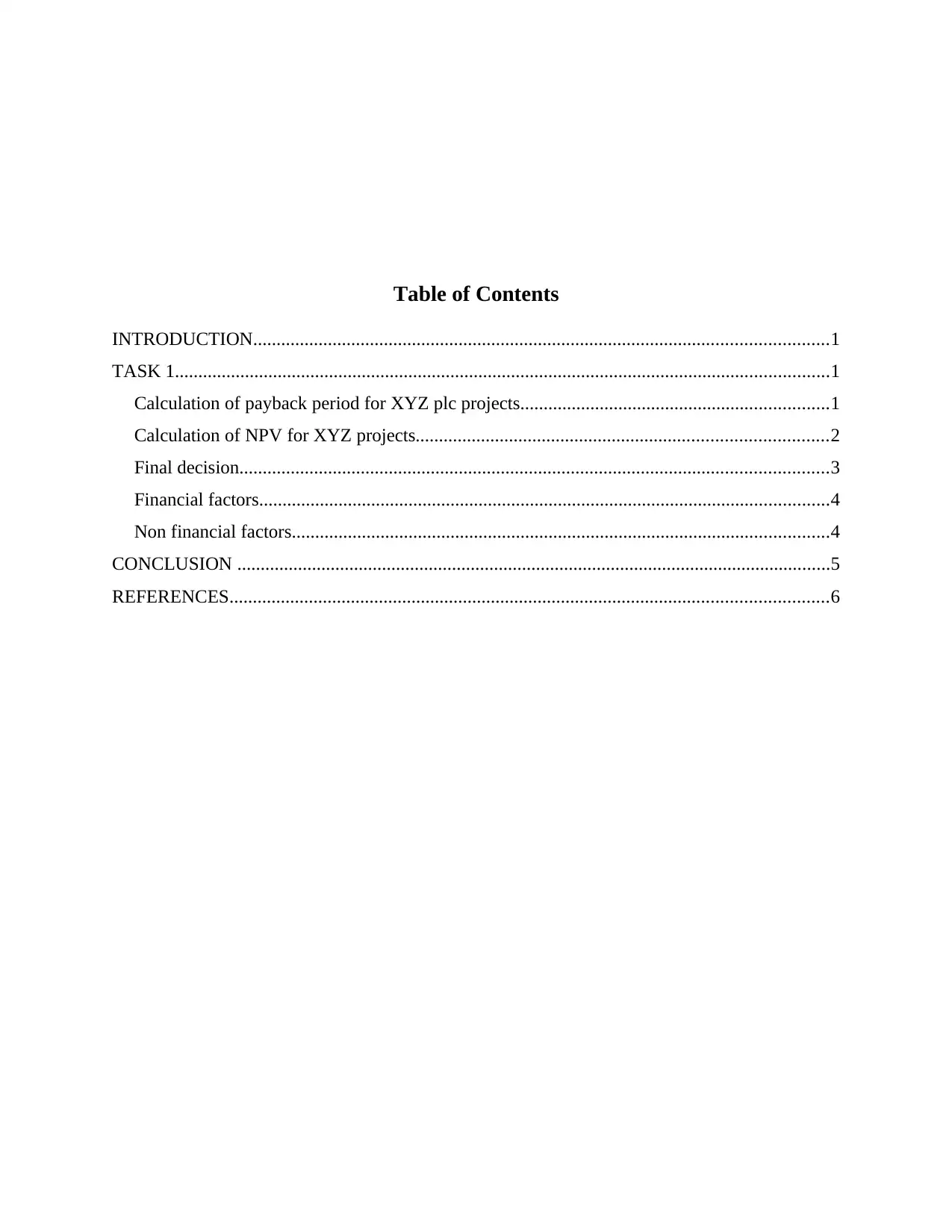
Table of Contents
INTRODUCTION...........................................................................................................................1
TASK 1............................................................................................................................................1
Calculation of payback period for XYZ plc projects..................................................................1
Calculation of NPV for XYZ projects........................................................................................2
Final decision..............................................................................................................................3
Financial factors..........................................................................................................................4
Non financial factors...................................................................................................................4
CONCLUSION ...............................................................................................................................5
REFERENCES................................................................................................................................6
INTRODUCTION...........................................................................................................................1
TASK 1............................................................................................................................................1
Calculation of payback period for XYZ plc projects..................................................................1
Calculation of NPV for XYZ projects........................................................................................2
Final decision..............................................................................................................................3
Financial factors..........................................................................................................................4
Non financial factors...................................................................................................................4
CONCLUSION ...............................................................................................................................5
REFERENCES................................................................................................................................6
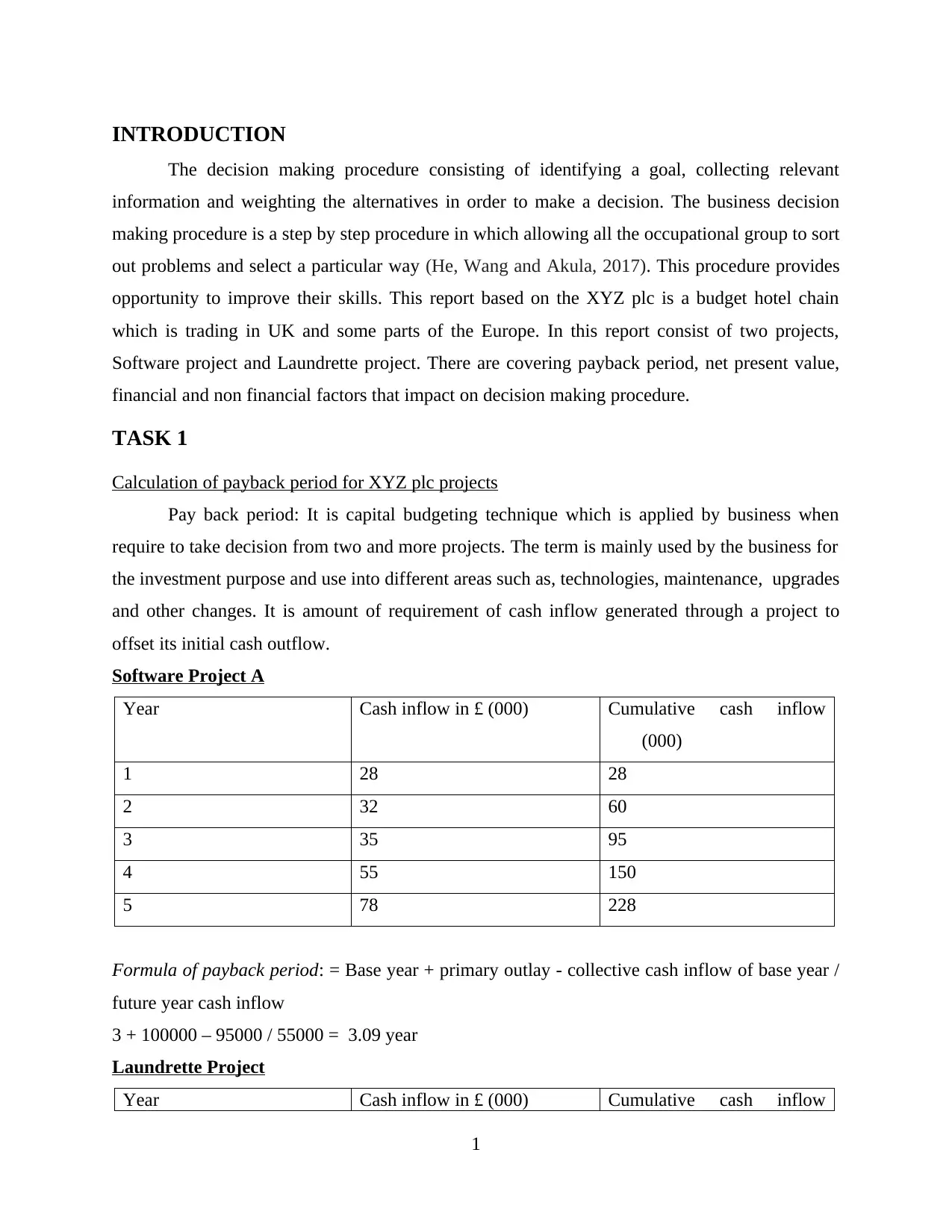
INTRODUCTION
The decision making procedure consisting of identifying a goal, collecting relevant
information and weighting the alternatives in order to make a decision. The business decision
making procedure is a step by step procedure in which allowing all the occupational group to sort
out problems and select a particular way (He, Wang and Akula, 2017). This procedure provides
opportunity to improve their skills. This report based on the XYZ plc is a budget hotel chain
which is trading in UK and some parts of the Europe. In this report consist of two projects,
Software project and Laundrette project. There are covering payback period, net present value,
financial and non financial factors that impact on decision making procedure.
TASK 1
Calculation of payback period for XYZ plc projects
Pay back period: It is capital budgeting technique which is applied by business when
require to take decision from two and more projects. The term is mainly used by the business for
the investment purpose and use into different areas such as, technologies, maintenance, upgrades
and other changes. It is amount of requirement of cash inflow generated through a project to
offset its initial cash outflow.
Software Project A
Year Cash inflow in £ (000) Cumulative cash inflow
(000)
1 28 28
2 32 60
3 35 95
4 55 150
5 78 228
Formula of payback period: = Base year + primary outlay - collective cash inflow of base year /
future year cash inflow
3 + 100000 – 95000 / 55000 = 3.09 year
Laundrette Project
Year Cash inflow in £ (000) Cumulative cash inflow
1
The decision making procedure consisting of identifying a goal, collecting relevant
information and weighting the alternatives in order to make a decision. The business decision
making procedure is a step by step procedure in which allowing all the occupational group to sort
out problems and select a particular way (He, Wang and Akula, 2017). This procedure provides
opportunity to improve their skills. This report based on the XYZ plc is a budget hotel chain
which is trading in UK and some parts of the Europe. In this report consist of two projects,
Software project and Laundrette project. There are covering payback period, net present value,
financial and non financial factors that impact on decision making procedure.
TASK 1
Calculation of payback period for XYZ plc projects
Pay back period: It is capital budgeting technique which is applied by business when
require to take decision from two and more projects. The term is mainly used by the business for
the investment purpose and use into different areas such as, technologies, maintenance, upgrades
and other changes. It is amount of requirement of cash inflow generated through a project to
offset its initial cash outflow.
Software Project A
Year Cash inflow in £ (000) Cumulative cash inflow
(000)
1 28 28
2 32 60
3 35 95
4 55 150
5 78 228
Formula of payback period: = Base year + primary outlay - collective cash inflow of base year /
future year cash inflow
3 + 100000 – 95000 / 55000 = 3.09 year
Laundrette Project
Year Cash inflow in £ (000) Cumulative cash inflow
1
⊘ This is a preview!⊘
Do you want full access?
Subscribe today to unlock all pages.

Trusted by 1+ million students worldwide
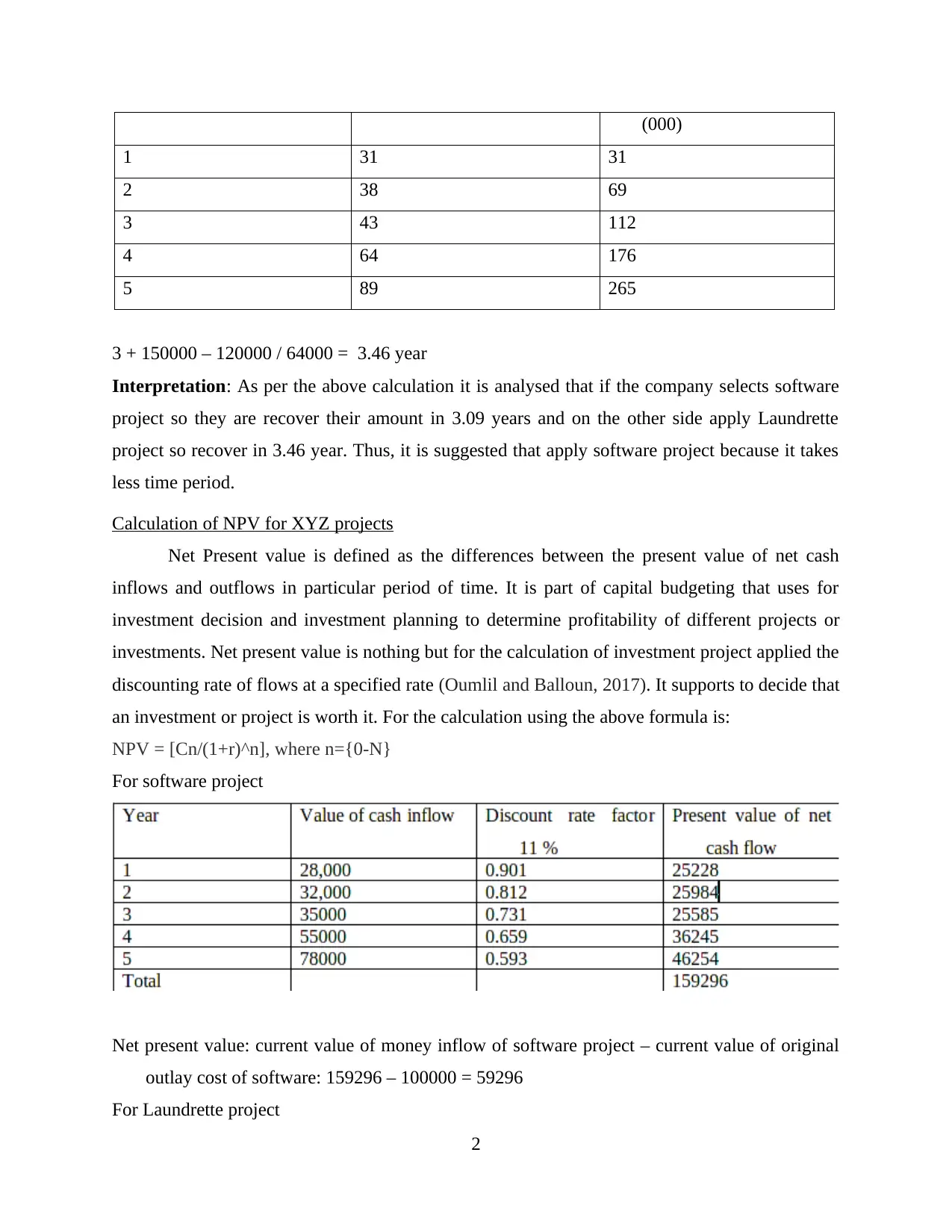
(000)
1 31 31
2 38 69
3 43 112
4 64 176
5 89 265
3 + 150000 – 120000 / 64000 = 3.46 year
Interpretation: As per the above calculation it is analysed that if the company selects software
project so they are recover their amount in 3.09 years and on the other side apply Laundrette
project so recover in 3.46 year. Thus, it is suggested that apply software project because it takes
less time period.
Calculation of NPV for XYZ projects
Net Present value is defined as the differences between the present value of net cash
inflows and outflows in particular period of time. It is part of capital budgeting that uses for
investment decision and investment planning to determine profitability of different projects or
investments. Net present value is nothing but for the calculation of investment project applied the
discounting rate of flows at a specified rate (Oumlil and Balloun, 2017). It supports to decide that
an investment or project is worth it. For the calculation using the above formula is:
NPV = [Cn/(1+r)^n], where n={0-N}
For software project
Net present value: current value of money inflow of software project – current value of original
outlay cost of software: 159296 – 100000 = 59296
For Laundrette project
2
1 31 31
2 38 69
3 43 112
4 64 176
5 89 265
3 + 150000 – 120000 / 64000 = 3.46 year
Interpretation: As per the above calculation it is analysed that if the company selects software
project so they are recover their amount in 3.09 years and on the other side apply Laundrette
project so recover in 3.46 year. Thus, it is suggested that apply software project because it takes
less time period.
Calculation of NPV for XYZ projects
Net Present value is defined as the differences between the present value of net cash
inflows and outflows in particular period of time. It is part of capital budgeting that uses for
investment decision and investment planning to determine profitability of different projects or
investments. Net present value is nothing but for the calculation of investment project applied the
discounting rate of flows at a specified rate (Oumlil and Balloun, 2017). It supports to decide that
an investment or project is worth it. For the calculation using the above formula is:
NPV = [Cn/(1+r)^n], where n={0-N}
For software project
Net present value: current value of money inflow of software project – current value of original
outlay cost of software: 159296 – 100000 = 59296
For Laundrette project
2
Paraphrase This Document
Need a fresh take? Get an instant paraphrase of this document with our AI Paraphraser

3
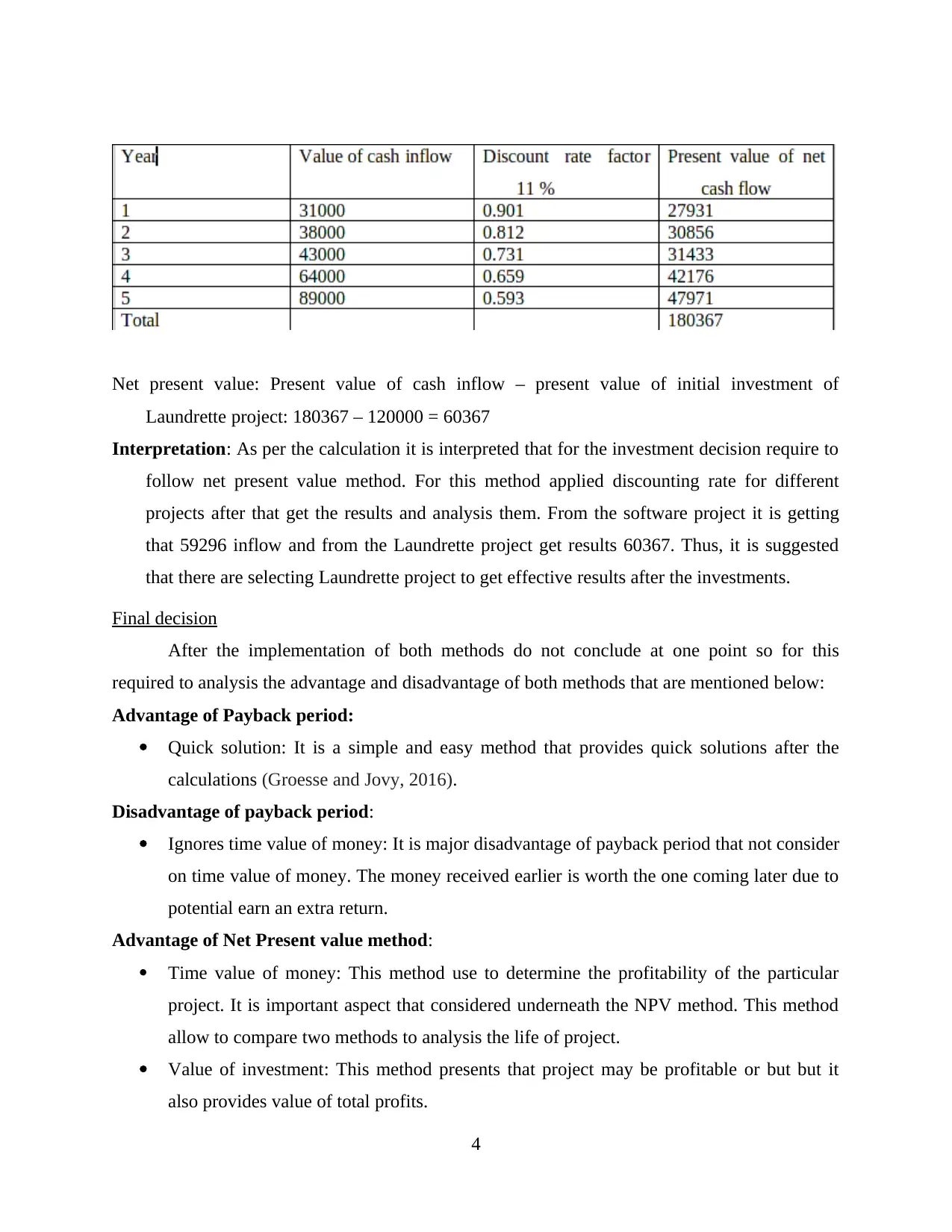
Net present value: Present value of cash inflow – present value of initial investment of
Laundrette project: 180367 – 120000 = 60367
Interpretation: As per the calculation it is interpreted that for the investment decision require to
follow net present value method. For this method applied discounting rate for different
projects after that get the results and analysis them. From the software project it is getting
that 59296 inflow and from the Laundrette project get results 60367. Thus, it is suggested
that there are selecting Laundrette project to get effective results after the investments.
Final decision
After the implementation of both methods do not conclude at one point so for this
required to analysis the advantage and disadvantage of both methods that are mentioned below:
Advantage of Payback period:
Quick solution: It is a simple and easy method that provides quick solutions after the
calculations (Groesse and Jovy, 2016).
Disadvantage of payback period:
Ignores time value of money: It is major disadvantage of payback period that not consider
on time value of money. The money received earlier is worth the one coming later due to
potential earn an extra return.
Advantage of Net Present value method:
Time value of money: This method use to determine the profitability of the particular
project. It is important aspect that considered underneath the NPV method. This method
allow to compare two methods to analysis the life of project.
Value of investment: This method presents that project may be profitable or but but it
also provides value of total profits.
4
Laundrette project: 180367 – 120000 = 60367
Interpretation: As per the calculation it is interpreted that for the investment decision require to
follow net present value method. For this method applied discounting rate for different
projects after that get the results and analysis them. From the software project it is getting
that 59296 inflow and from the Laundrette project get results 60367. Thus, it is suggested
that there are selecting Laundrette project to get effective results after the investments.
Final decision
After the implementation of both methods do not conclude at one point so for this
required to analysis the advantage and disadvantage of both methods that are mentioned below:
Advantage of Payback period:
Quick solution: It is a simple and easy method that provides quick solutions after the
calculations (Groesse and Jovy, 2016).
Disadvantage of payback period:
Ignores time value of money: It is major disadvantage of payback period that not consider
on time value of money. The money received earlier is worth the one coming later due to
potential earn an extra return.
Advantage of Net Present value method:
Time value of money: This method use to determine the profitability of the particular
project. It is important aspect that considered underneath the NPV method. This method
allow to compare two methods to analysis the life of project.
Value of investment: This method presents that project may be profitable or but but it
also provides value of total profits.
4
⊘ This is a preview!⊘
Do you want full access?
Subscribe today to unlock all pages.

Trusted by 1+ million students worldwide
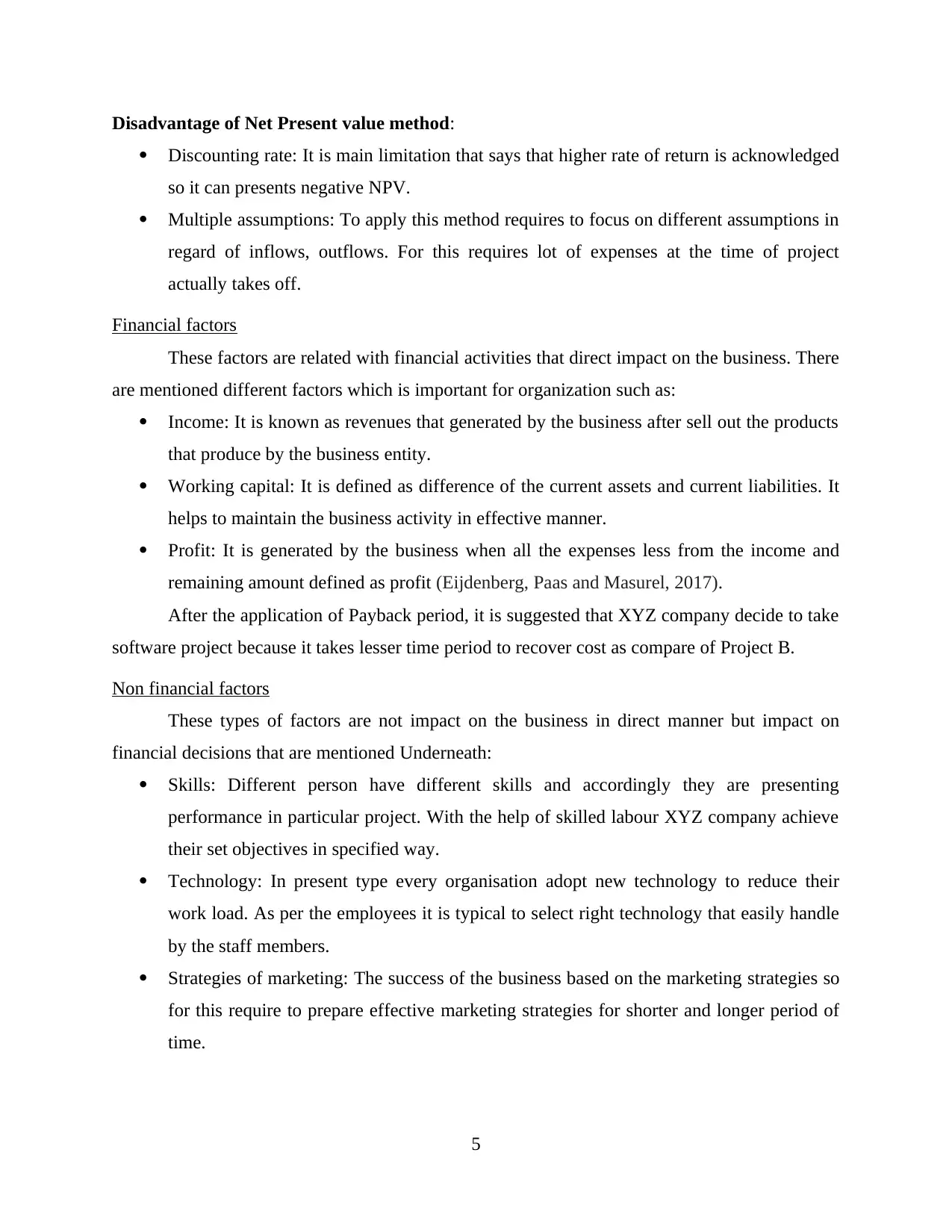
Disadvantage of Net Present value method:
Discounting rate: It is main limitation that says that higher rate of return is acknowledged
so it can presents negative NPV.
Multiple assumptions: To apply this method requires to focus on different assumptions in
regard of inflows, outflows. For this requires lot of expenses at the time of project
actually takes off.
Financial factors
These factors are related with financial activities that direct impact on the business. There
are mentioned different factors which is important for organization such as:
Income: It is known as revenues that generated by the business after sell out the products
that produce by the business entity.
Working capital: It is defined as difference of the current assets and current liabilities. It
helps to maintain the business activity in effective manner.
Profit: It is generated by the business when all the expenses less from the income and
remaining amount defined as profit (Eijdenberg, Paas and Masurel, 2017).
After the application of Payback period, it is suggested that XYZ company decide to take
software project because it takes lesser time period to recover cost as compare of Project B.
Non financial factors
These types of factors are not impact on the business in direct manner but impact on
financial decisions that are mentioned Underneath:
Skills: Different person have different skills and accordingly they are presenting
performance in particular project. With the help of skilled labour XYZ company achieve
their set objectives in specified way.
Technology: In present type every organisation adopt new technology to reduce their
work load. As per the employees it is typical to select right technology that easily handle
by the staff members.
Strategies of marketing: The success of the business based on the marketing strategies so
for this require to prepare effective marketing strategies for shorter and longer period of
time.
5
Discounting rate: It is main limitation that says that higher rate of return is acknowledged
so it can presents negative NPV.
Multiple assumptions: To apply this method requires to focus on different assumptions in
regard of inflows, outflows. For this requires lot of expenses at the time of project
actually takes off.
Financial factors
These factors are related with financial activities that direct impact on the business. There
are mentioned different factors which is important for organization such as:
Income: It is known as revenues that generated by the business after sell out the products
that produce by the business entity.
Working capital: It is defined as difference of the current assets and current liabilities. It
helps to maintain the business activity in effective manner.
Profit: It is generated by the business when all the expenses less from the income and
remaining amount defined as profit (Eijdenberg, Paas and Masurel, 2017).
After the application of Payback period, it is suggested that XYZ company decide to take
software project because it takes lesser time period to recover cost as compare of Project B.
Non financial factors
These types of factors are not impact on the business in direct manner but impact on
financial decisions that are mentioned Underneath:
Skills: Different person have different skills and accordingly they are presenting
performance in particular project. With the help of skilled labour XYZ company achieve
their set objectives in specified way.
Technology: In present type every organisation adopt new technology to reduce their
work load. As per the employees it is typical to select right technology that easily handle
by the staff members.
Strategies of marketing: The success of the business based on the marketing strategies so
for this require to prepare effective marketing strategies for shorter and longer period of
time.
5
Paraphrase This Document
Need a fresh take? Get an instant paraphrase of this document with our AI Paraphraser

CONCLUSION
As per the above report it has been concluded that a business can not survive without
effective financial decision. According to Pay back period select software project that provides
return on investment in shorter period of time. It helps to apply new technology in company and
complete task on time.
6
As per the above report it has been concluded that a business can not survive without
effective financial decision. According to Pay back period select software project that provides
return on investment in shorter period of time. It helps to apply new technology in company and
complete task on time.
6

REFERENCES
Books and Journals
He, W., Wang, F. K. and Akula, V., 2017. Managing extracted knowledge from big social media
data for business decision making. Journal of Knowledge Management.
Oumlil, A. B. and Balloun, J. L., 2017. Cultural variations and ethical business decision making:
a study of individualistic and collective cultures. Journal of Business & Industrial
Marketing.
Groesser, S. N. and Jovy, N., 2016. Business model analysis using computational modeling: A
strategy tool for exploration and decision-making. Journal of Management Control.
27(1). pp.61-88.
Eijdenberg, E. L., Paas, L. J. and Masurel, E., 2017. Decision-making and small business growth
in Burundi. Journal of Entrepreneurship in Emerging Economies.
7
Books and Journals
He, W., Wang, F. K. and Akula, V., 2017. Managing extracted knowledge from big social media
data for business decision making. Journal of Knowledge Management.
Oumlil, A. B. and Balloun, J. L., 2017. Cultural variations and ethical business decision making:
a study of individualistic and collective cultures. Journal of Business & Industrial
Marketing.
Groesser, S. N. and Jovy, N., 2016. Business model analysis using computational modeling: A
strategy tool for exploration and decision-making. Journal of Management Control.
27(1). pp.61-88.
Eijdenberg, E. L., Paas, L. J. and Masurel, E., 2017. Decision-making and small business growth
in Burundi. Journal of Entrepreneurship in Emerging Economies.
7
⊘ This is a preview!⊘
Do you want full access?
Subscribe today to unlock all pages.

Trusted by 1+ million students worldwide
1 out of 9
Related Documents
Your All-in-One AI-Powered Toolkit for Academic Success.
+13062052269
info@desklib.com
Available 24*7 on WhatsApp / Email
![[object Object]](/_next/static/media/star-bottom.7253800d.svg)
Unlock your academic potential
Copyright © 2020–2025 A2Z Services. All Rights Reserved. Developed and managed by ZUCOL.





